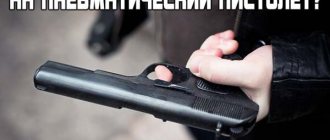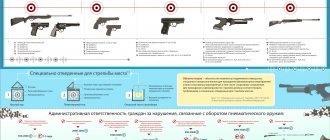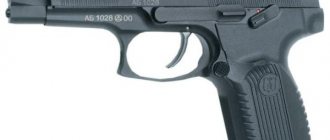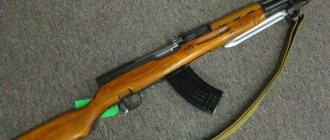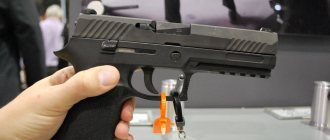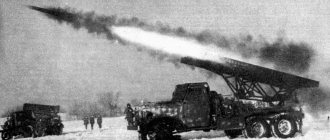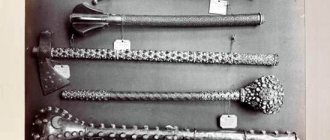The legislative framework
The turnover is regulated by Federal Law No. 150 “On Weapons” dated December 13, 1996. A division based on muzzle energy is introduced, and basic handling rules are established:
– cannot be used against living creatures, except in cases of permitted hunting for specially designated types of prey;
– you cannot use pneumatics within the city;
– pneumatics with muzzle energy above 7.5 J require registration and licensing with the Ministry of Internal Affairs.
The law provides for the use of this type of weapon for sporting purposes, for target practice shooting, and, according to the decree of the Government of the Russian Federation dated January 10, 2009, for hunting small animals and birds.
Conditions and cost of delivery of pneumatic weapons to cities and regions of the Russian Federation
Our store operates on the principle of 100% prepayment . MMG, pneumatic , signal weapons - we ship only by transport companies! (We work with most well-known transport companies - PEC, Autotrading, Business Lines, etc.) At the moment there are regular flights to most cities! Minimum delivery cost! Exact dates!
Ordering a product will take you only 3 steps
- 1) Place the desired product in the cart - fill in the information necessary to submit the order.
- 2) We receive an invoice and step-by-step instructions for paying for the order.
- 3) We pay the bill, we receive a tracker number for tracking the location of the goods. We receive the order.
Classification by muzzle energy
Muzzle energy is a parameter based on which the law establishes the procedure for using pneumatics. It characterizes the power, determines the flight range and the degree of impact the bullet has on the target.
Pneumatic weapons with muzzle energy less than 3 J are not considered weapons on the territory of the Russian Federation. Such products are not subject to registration and do not require permits. The use of this type of weapon is limited to the entertainment sector.
Products with a muzzle energy of 3 - 7.5 J are considered sporting (hunting) weapons, but they can be purchased without a license. This rule applies if the caliber is less than 4.5 mm.
If an air rifle or pistol has a muzzle energy between 7.5 and 25 J, a license is required. Such pneumatics use calibers from 4.5 to 6.35 mm and are used for professional sports shooting and hunting.
Equipment with muzzle energy above 25 J is not regulated by Russian legislation. The storage and use of this type of rifles and pistols is not regulated.
Quackenbush LA Outlaw .458 – the most powerful rifle of the 21st century
The first thing that comes to mind for gun experts when asked, “What is the strongest air rifle?” is, of course, the Quackenbush rifle. Indeed, the Quackenbush LA Outlaw .458, the brainchild of a Missouri company of the same name, breaks all records for muzzle power.
It is worth noting that the heavier the ammunition, the lower the power.
It’s interesting, but in gun circles the presented model is often called a “hellish thing”, because even a bear can be killed with a few shots from it. Information about which is the most powerful spring-piston air rifle here. See also information about the Three-Ruler, why is it called that?
Appearance
Only the best types of walnut wood were used for the fore-end and butt of this sample. The dimensions of the stock are quite impressive, so using the Quackenbush LA Outlaw .458 will be more convenient for an adult . As for the forend, it is of a narrow oblong shape with a rectangular profile.
The rifle barrel is made of polished blue-black metal. And the receiver is made of the same metal, but with designer engraving. If you look at the Quackenbush work in profile, you might think that this is a real shotgun, and not a pneumatic gun!
Technical and design features
- The maximum power is 687 J.
- All .0.458 caliber rifle bullets are suitable for shooting from the presented model.
- The initial velocity of the ammunition when fired reaches 223 m/s.
- The trunk length is 66 cm.
- The total length reaches 1.12 m.
- Dragon Claw weighs 3.6 kg.
Advantages and disadvantages
The main advantages the Quackenbush LA Outlaw .458 include:
- the highest power among all currently existing air rifles;
- Any type of rifle ammunition is suitable for shooting.
Disadvantages of the product:
- it is not possible to obtain a license for this design in Russia;
- intended only for professional shooters;
Classification by caliber
There are many different types of ammunition available for pneumatics. To shoot from rifled weapons of this type, take lead bullets of 4.5 mm, 5.5 mm, up to 12.7 mm. The most popular caliber is 4.5 mm, others are used less frequently and are used in samples produced abroad.
For pneumatics used for recreational purposes, there are different types of equipment, divided by caliber and type of material. For the military sports game “airsoft”, plastic ammunition measuring 6-8 mm is used. In paintball, paint tanks with a diameter of 10 or 14 mm act as bullets. Hardball players use steel balls with a copper shell, 4.5 mm in size. According to the law, these types of rifles and pistols are classified as sports equipment.
Design of spring-piston systems
The spring-piston system is quite reliable and allows a 4.5 mm bullet to reach speeds of up to 380 m/s. The energy of the shot is provided by a spring, which is cocked using the muscular strength of a person, or using an electric motor.
The spring is connected to a piston located inside the cylinder. The reservoir contains air that does the work of pushing the bullet out. On one side of the container there is a piston and a spring, on the other there is a connection between the cylinder and the barrel.
When fired, the spring expands, causing the piston to move. Air compression occurs when the pressure exceeds the friction holding the bullet, it begins to move and, acquiring greater speed, flies out of the barrel.
These systems are characterized by a high degree of repeatability, which is achieved due to the invariability of the processes leading to the shot. The deterioration of characteristics occurs solely over time - the metal of the spring wears out, it loses the necessary rigidity. Replacing the element allows you to restore the power of your rifle or pistol. Another distinctive feature is the silent shot. The loudest sounds will be those arising from the collision of the spring coils and the movement of the piston.
Main manufacturers
The main manufacturers of air guns are:
- Russia
: IZHMEKH, Anix, Kalibr LLC, EDgan LLC, Demyan LLC, KSPZ CJSC; - Czech Republic
: CZ; - Taiwan
: KWC; - Austria
: Steyr; - Germany
: Umarex, Weihrauch, Diana RWS, Walther, Suhl Haenel, JG Anschütz, Feinwerkbau; - Denmark
: ASG; - England, Sweden
: Logun, Webley, BSA Guns, FX Airguns, Gunpower Airguns, Air Arms; - USA
: Crosman, Daisy, Benjamin, Borner, Gletcher, AirForce; - Spain
: Norica, Gamo, Cometa; - Turkey
: Hatsan, Kral, Torun Arms; - France:
Cybergun; - Mexico
: Mendoza; - China
: Shanghai, BAM, BMK; - Korea: Evanix, Sumatra;
It's not uncommon for Crosman to produce something for Umarex, as they do with the Beretta Elite II and Walther PPK/S pistols.
Umarex produces a large number of weapons under the brands: Ruger, Walther, Colt, Browning, Hammerli, Beretta, Magnum.
Construction of gas cylinder systems
The shot is ensured by the pressure of carbon dioxide. The release valve opens the reservoir and the compressed gas reaches the bullet and causes it to move down the barrel. The power is enough to provide take-off speeds of up to 120 m/s.
To create the required pressure, small cylinders containing liquefied carbon dioxide are used. They are disposable - 8, 12 grams, reusable - rechargeable. The tank and the cylinder are a single vessel where CO2 is in an equilibrium state - one part is liquid, the other is gaseous. When the next portion is consumed, instantaneous evaporation occurs, restoring the pressure after closing the valve.
If the ambient temperature is below 0 °C, then the gas condenses and the pressure decreases. This leads to a decrease in power, which means the bullet’s ejection speed will not be high. Another disadvantage is the insufficient tightness of the valve. The gas comes out and the required pressure can be maintained for about 5 hours. If you use the cylinder longer, the pressure will no longer be enough to push the bullet out.
The repeatability of gas cylinder designs is less than that of other pneumatic systems. During shooting, it manifests itself in the form of a decrease in the point of impact by 1.5-2 cm, depending on the emptying of the cylinder. The use of pressure stabilizers reduces this negative effect.
Compression and multi-compression pneumatic device
Compression-type pneumatics fire shots using gas pressure in the tank. A distinctive feature is the pumping method: air is pumped through a lever built into the design of the weapon. It moves the piston, creating increased pressure.
The shot occurs when the valve opens, releasing air from the reservoir into the barrel. The gas picks up the bullet, pushes it out with force, and the ejection speed reaches 200 m/s. Pumping is done in one motion, the pressure reserve is enough for one shot. The design provides a high degree of repeatability, which allows for high shooting accuracy.
In systems called multi-compression, charging is done in several movements. It is not difficult to achieve higher pressures than in single-shot designs, so the muzzle energy is higher and the speed can reach 280 m/s.
The disadvantages of the systems are the need for physical effort to fire a shot. High demands on valves - they clog quickly and can fail if unpurified air is used. The reduced rate of fire is the main fatal drawback of the system, due to the peculiarities of the loading principle.
PCP device
The shot is fired using air under pressure of 200 - 300 atmospheres. To achieve these parameters, a special compressor or cylinder similar to scuba divers' equipment is used.
The tank is equipped with two valves: a charging valve - pumping occurs through it - and an outlet valve, when opened, a shot is fired. An important part of the design is a reducer, which reduces the outlet pressure to 70 atmospheres. After one load, you can fire up to 20 shots without reducing performance.
When the pressure drops, you need to recharge again. The system for increasing the pressure in the tank is not part of the weapon and is a separate device. To avoid damaging the valves, you must use purified air or nitrogen. Equipment for charging scuba gear can provide the required quality of gas. Therefore, it is often used in working with PCP.
A distinctive feature of PCP pneumatics is its high power: bullet speed reaches 300 m/s, even using a 5.5 mm caliber. These parameters have a positive effect on accuracy, which is considered the best among all types of air guns. Negative qualities include the high cost and complexity of transportation, which arises from the need to take additional charging equipment with you.
Air guns
Main article: Pneumatic artillery
Marine 10.5 inch air gun.
A 2.5-inch land gun that used a powder gas generator for firing. Nearby are depicted an oblong feathered projectile for it and a gunpowder bomb, which serves as a source of energy.
Pneumatic artillery experienced a short burst of popularity immediately after the invention of the first powerful explosives, which could not be used in conventional gunpowder artillery shells because they were too sensitive, or when in contact with metal during storage of the shell, they formed particularly sensitive compounds, and when fired could spontaneously detonate directly in the bore. In such conditions, the ability of pneumatic weapons to smoothly regulate the increase in pressure, eliminating a sharp jolt when firing, turned out to be very attractive.
The greatest success was achieved by the Americans, who in the 1880s developed and adopted smooth-bore 8-inch and 15-inch pneumatic guns for the fleet and coastal batteries in the 1880s, firing elongated, feathered high-explosive projectiles (often described as “outwardly resembling rockets”), which contained, respectively, , about 50 and 100 kg of explosive (wet pyroxylin). The initial velocity of the projectile reached 250 m/s, the maximum firing range was 4.5...5 kilometers, and a direct hit on the enemy ship was not required - in addition to the usual contact fuse, the projectiles were also equipped with an electrochemical one, which fired with a slight delay after the warhead hit projectile into the water, hitting the underwater hull of an enemy ship. The trajectory of the projectile was hinged, and the approach time to the target reached 12 seconds, so pneumatic guns were mainly considered as an alternative to torpedoes of that time, which were not distinguished by either a long range or high firing accuracy. To power the gun, a 140-atmospheric compressor powered by a steam engine was used. The first version of the 15-inch gun was installed permanently in the ship's hull, so that guidance was carried out by the entire hull, but this turned out to be an unsuccessful solution, and later versions were developed as conventional pin deck installations.
The effect of air guns on their target was more than satisfactory, and in the literature of the late 19th century they were described as weapons of exceptional destructive power, capable of seriously changing the face of war at sea. The fact is that the enormous power of the explosion of their shells, unattainable for traditional artillery of that time, left no chance even for battleships, and the small mass and lack of recoil made it possible to install high-power pneumatic guns on small ships or even converted merchant ships:
| The improvement of the air gun would be tantamount to a fatal blow to all modern ships, since it is difficult to even imagine how they could be protected from such projectiles. Due to the fact that the shock during pneumatic shooting is very insignificant, such guns can be safely installed on commercial ships, which was already done on the Niteróya during the Brazilian War - H. Wilson, “Ironclads in Battle.” |
Meanwhile, explosives were rapidly improving, and already in the Russo-Japanese War, the Japanese with great success applied powerful high-explosive shells developed in England to conventional large-caliber artillery, which, as expected, turned out to be very destructive weapons. The Japanese 12-inch (305 mm) high-explosive projectile contained about 50 kg of trinitrophenol (“lyddite”, “Shimose melinite”) in a special protective shell of tin foil, which did not form particularly sensitive chemical compounds upon contact with trinitrophenol. Russia also developed shells filled with specially stabilized pyroxylin, but their design was unsuccessful, the fuses were unreliable, and the explosive charge was too weak, which became one of the reasons for the Tsushima tragedy of the Russian fleet. Later, trinitrotoluene and tetranitropentaerythritol were also used in naval artillery shells. Finally, subsequently, after the advent of military aviation, the same principle of destroying a ship with the explosion of a large amount of explosive was used as the basis for the principle of operation of air bombs, which finally put an end to the era of the armored fleet.
Pneumatic artillery did not keep up with the development of firearms, and after the firing range of the latter reached 10 kilometers or more at the beginning of the 20th century, it turned out to be uncompetitive - the coastal battery of pneumatic guns installed near New York by that time could easily be shot from ships located far beyond its maximum firing range. Added to this were also the specific problems of pneumatic artillery associated with the relatively low development of technology at the turn of the 19th and 20th centuries - in particular, air leaks and unreliable operation of numerous valve devices were its constant companions.
In the USA, there was also a field pneumatic gun of the Sims and Dudley system with a caliber of 2.5 inches (64 mm), in which, instead of a compressor, a powder gas generator was used, located in a pipe parallel to the barrel. The gun was mounted on a wheeled machine, which was common for artillery of that time. Its only advantage over a gunpowder weapon was its relative noiselessness, due to which it was used with limited success in the Spanish-American War of 1898 for sabotage purposes, and subsequently also fell out of use. True, in the First World War, the French and Austrians widely used pneumatic mortars in trench warfare, which threw a mine with a caliber of up to 200 mm and a weight of up to 35 kg at a distance of about 1 km, but here, too, the air was eventually replaced by gunpowder.
Practical use
Pneumatics are a convenient, inexpensive type of weapon that helps you master the basic principles of shooting and develop the necessary skills. Widely used in sports disciplines and for educational and training events. The big advantage is simplicity and safety.
Pneumatics also occupy an important place in a hunter’s arsenal. It is suitable for hunting small game - birds, rodents. Professionals note the following advantages: conditional lack of recoil, low cost of ammunition, low shot volume, ease of maintenance.
Fans of active recreation and military sports games appreciate this type of equipment. It is used for airsoft, hardball, and paintball. Pneumatics that imitate the appearance of weapons are in demand among reenactors. It finds application in staging historical battles.
When purchasing air guns, you should remember the need to comply with legal requirements. Possessing low muzzle energy and low power, pneumatics have sufficient destructive force to cause damage to health. Therefore, it requires careful handling and responsible attitude during storage and operation.
Summary
If we take into account all the useful features and weaknesses of air rifles, we can come to the conclusion: such a weapon is not universal for every hunter, because... requires certain skills, without which effective use is simply impossible. The main disadvantage of an air rifle is its much lower killing power compared to its firearm counterparts. Well, in skillful hands it is not inferior in efficiency to a classic shotgun or carbine.
all stories in this section
| More stories: |
| Moose hunting on the roar |
| How to prepare for a wild boar hunt: places, hunting seasons and recommendations |
| Hunting with a slingshot is an extraordinary form of entertainment |
| Hunting for bear and wild boar in the Chelyabinsk region |
| Hunting for a brown bear |
| Hunting for wood grouse in the spring lek |
| Boar hunting: wild boar slaughter places |
| Moose hunting in autumn |
| Hunting for roe deer in a pen |
| Bear Hunt: My First Bear |
| All articles about hunting |
| Opening of winter hunting November 2020 (Chelyabinsk region) |
| Autumn hunting September-October 2020 (Sverdlovsk region) |
| Marmot hunting July 2019 (Chelyabinsk region) |
| Moose hunting October 2018 (Sverdlovsk region) |
| Deer hunting September 2020 (Tyumen region) |
| Wild boar hunting August 2020 (Sverdlovsk region) |
| Hare hunting February 2020 (Sverdlovsk region) |
| Hunting for elk and wild boar September-October 2020 (Sverdlovsk region) |
| Hunting for fallow deer September 2020 (Kaliningrad region) |
| Fox hunting February 2020 (Sverdlovsk region) |
| All photos from the hunt |
| Hunting for elk and goat video online |
| Hunting for wood grouse in spring 2013 video online |
| Boar hunt 2012 video online |
| Winter moose hunting from the approach video online |
| Driven moose hunting video online |
| Spring hunt 2011 video online |
| Roe deer hunting video online |
| Hunting a goat during the rut video online |
| Moose hunting: precise shot video online |
| Bear hunting video online |
| All hunting and fishing on video |
